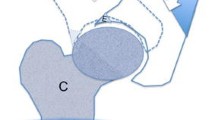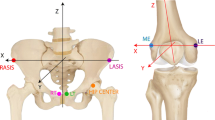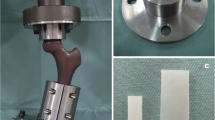Abstract
Purpose
Knowledge of the effect of hip pathologies on hip biomechanics is important to the understanding of the development of osteoarthritis, and the contribution of the labrum to hip joint stability has had limited study. The purpose of this study was to evaluate the effect of labral injury to stability of the femoral head in the acetabular socket.
Methods
Ten cadaver hip specimens were tested using a robotic system under four different loading conditions: axial loading (80 N) along the femoral axis and axial loading (80 N) combined with either anterior, posterior or lateral loading (60 N). The hip states were examined were intact, with a 1.5 cm capsulotomy and with a 1 cm resection of the anterosuperior labrum.
Results
At 30° of flexion, under axial load, the displacement of the hip with capsulotomy and labral resection (9.6 ± 2.5 mm) was significantly larger then the hip with capsulotomy alone (5.6 ± 4.1 mm, p = 0.005) and the intact hip (5.2 ± 3.8 mm, p = 0.005). Also, at 30° of flexion, the displacement under combined axial and anterior/posterior load was increased with capsulotomy and labral resection.
Conclusion
The acetabular labrum provides stability to the hip joint in response to a distraction force and combined distraction and translation forces. One centimetre of labral resection caused significant displacement (“wobbling” effect) of the femoral head within the acetabulum with normal range of motion. Successful labral repair could be crucial for restoration of the hip biomechanics and prevention of coxarthrosis.





Similar content being viewed by others
References
Beck M, Kalhor M, Leunig M, Ganz R (2005) Hip morphology influences the pattern of damage to the acetabular cartilage: femoroacetabular impingement as a cause of early osteoarthritis of the hip. J Bone Joint Surg Br 87:1012–1018
Beckmann J, Luring C, Tingart M, Anders S, Grifka J, Kock FX (2009) Cup positioning in THA: current status and pitfalls. A systematic evaluation of the literature. Arch Orthop Trauma Surg 129:863–872
Byrd JW, Jones KS (2009) Hip arthroscopy for labral pathology: prospective analysis with 10-year follow-up. Arthroscopy 25:365–368
Crawford MJ, Dy CJ, Alexander JW, Thompson M, Schroder SJ, Vega CE, Patel RV, McCarthy JC, Lowe WR, Noble PC (2007) The 2007 Frank Stinchfield Award. The biomechanics of the hip labrum and the stability of the hip. Clin Orthop Relat Res 465:16–22
DiGioia AM, Hafez MA, Jaramaz B, Levison TJ, Moody JE (2006) Functional pelvic orientation measured from lateral standing and sitting radiographs. Clin Orthop Relat Res 453:272–276
Espinosa N, Rothenfluh DA, Beck M, Ganz R, Leunig M (2006) Treatment of femoro-acetabular impingement: preliminary results of labral refixation. J Bone Joint Surg Am 88:925–935
Feeley BT, Powell JW, Muller MS, Barnes RP, Warren RF, Kelly BT (2008) Hip injuries and labral tears in the national football league. Am J Sports Med 36:2187–2195
Ferguson SJ, Bryant JT, Ganz R, Ito K (2000) The acetabular labrum seal: a poroelastic finite element model. Clin Biomech 15:463–468
Ferguson SJ, Bryant JT, Ganz R, Ito K (2000) The influence of the acetabular labrum on hip joint cartilage consolidation: a poroelastic finite element model. J Biomech 33:953–960
Ferguson SJ, Bryant JT, Ganz R, Ito K (2003) An in vitro investigation of the acetabular labral seal in hip joint mechanics. J Biomech 36:171–178
Gabriel MT, Wong EK, Woo SL, Yagi M, Debski RE (2004) Distribution of in situ forces in the anterior cruciate ligament in response to rotatory loads. J Orthop Res 22:85–89
Harner CD, Janaushek MA, Kanamori A, Yagi M, Vogrin TM, Woo SL (2000) Biomechanical analysis of a double-bundle posterior cruciate ligament reconstruction. Am J Sports Med 28:144–151
Harris JD, Slikker W, Gupta AK et al (2013) Routine complete capsular closure during hip arthroscopy. Arthrosc Tech 2:89–94
Henak C, Ellis B, Harris M, Anderson A, Peters C, Weiss J (2011) Role of the acetabular labrum in load support across the hip joint. J Biomech 44(12):2201–2206
Ito H, Song Y, Lindsey DP, Safran M, Giori N (2009) The proximal hip joint capsule and the zona orbicularis contribute to hip joint stability in distraction. J Orthop Research 27:989–995
Klaue K, Durnin CW, Ganz R (1991) The acetabular rim syndrome. A clinical presentation of dysplasia of the hip. J Bone Joint Surg Br 73:423–429
Kohnlein W, Ganz R, Impellizzeri FM, Leunig M (2009) Acetabular morphology: implications for joint-preserving surgery. Clin Orthop Relat Res 467:682–691
Komistek RD, Dennis DA, Ochoa JA, Haas BD, Hammill C (2002) In vivo comparison of hip separation after metal-on-metal or metal-on-polyethylene total hip arthroplasty. J Bone Joint Surg Am 84:1836–1841
Krych AJ, Thompson M, Larson CM, Byrd JW et al (2012) Is posterior hip instability associated with cam and pincer deformity? Clin Orthop Relat Res 470:3390–3397
Larson CM, Giveans MR (2009) Arthroscopic debridement versus refixation of the acetabular labrum associated with femoroacetabular impingement. Arthroscopy 25:369–376
Lertwanich P, Martins CAQ, Kato Y, Ingham SJH, Kramer S, Linde-Rosen M, Smolinski P, Fu F (2010) Contribution of the meniscofemoral ligament as a restraint to the posterior tibial translation in a porcine knee. Knee Surg Sports Traumatol Arthrosc 18:1277–1281
Lombardi AV, Mallory TH, Dennis DA, Komistek RD, Fada RA, Northcut FJ (2000) An in vivo determination of total hip arthroplasty pistoning during activity. J Arthroplasty 15:702–709
Martin HD, Savage A, Braly BA, Palmer IJ, Beall DP, Kelly B (2008) The function of the hip capsular ligaments: a quantitative report. Arthroscopy 24:188–195
McCarthy JC, Noble PC, Schuck MR, Wright J, Lee J (2001) The Otto E. Aufranc Award: The role of labral lesions to development of early degenerative hip disease. Clin Orthop Relat Res 393:25–37
Narvani AA, Tsiridis E, Kendall S, Chaudhuri R, Thomas P (2003) A preliminary report on prevalence of acetabular labrum tears in sports patients with groin pain. Knee Surg Sports Traumatol Arthrosc 11:403–408
Nepple JJ, Philippon MJ, Campbell KJ et al (2014) The hip fluid seal—Part II: the effect of an acetabular tear, repair, resection, and reconstruction on hip stability to distraction. Knee Surg Sports Traumatol Arthrosc 22(4):730–736
Nishihara S, Sugano N, Nishii T, Ohzono K, Yoshikawa H (2003) Measurements of pelvic flexion angle using three-dimensional computed tomography. Clin Orthop Relat Res 140–51, 123: 283–288
Petersen W, Petersen F, Tillmann B (2003) Structure and vascularization of the acetabular labrum with regard to the pathogenesis and healing of labral lesions. Arch Orthop Trauma Surg 123:283–288
Philippon MJ, Schenker ML (2005) Athletic hip injuries and capsular laxity. Oper Tech Orthop 15:261–266
Philippon MJ, Kuppersmith DA, Wolff AB, Briggs KK (2009) Arthroscopic findings following traumatic hip dislocation in 14 professional athletes. Arthroscopy 25:169–174
Philippon MJ, Briggs KK, Hay CJ, Kuppersmith DA, Dewing CB, Huang MJ (2010) Arthroscopic labral reconstruction in the hip using iliotibial band autograft: technique and early outcomes. Arthroscopy 26:750–756
Rudy TW, Livesay GA, Woo SL, Fu FH (1996) A combined robotic/universal force sensor approach to determine in situ forces of knee ligaments. J Biomech 29:1357–1360
Safran MR, Giordano G, Lindsay DP, Gold GE, Rosenberg J, Zaffagnini S, Giori NJ (2011) Strains across the acetabular labrum during hip motion: a cadaveric model. Am J Sports Med 39:92–102
Selders RM, Tan V, Hunt J, Katz M, Winiarsky R, Fitzgerald RH (2001) Anatomy, histological features and vascularity of the adult acetabular labrum. Clin Orthop Rel Res 382:232–240
Shindle MK, Voos JE, Nho SJ, Heyworth BE, Kelly BT (2008) Arthroscopic management of labral tears in the hip. J Bone Joint Surg Am 90(Suppl 4):2–19
Smith MV, Panchal HB, Thiele RA, Sekiya JK (2011) Effect of acetabular labrum tears on hip stability and labral strain in a joint compression model. Am J Sports Med 39:103–110
Song Y, Ito H, Kourtis L, Safran K, Carter D, Gion N (2012) Articular cartilage friction increases in hip joints after removal of the acetabular labrum. J Biomech 45(3):524–530
Takechi H, Nagashima H, Ito S (1982) Intra-articular pressure of the hip joint outside and inside the limbus. J Jpn Orthop Assoc 56:529–536
Tan V, Seldes RM, Katz MA, Freedhand AM, Klimkiewicz JJ, Fitzgerald RH Jr (2001) Contribution of acetabular labrum to articulating surface area and femoral head coverage in adult hip joints: an anatomic study in cadavera. Am J Orthop 30:809–812
Tayton E (2007) Femoral anteversion: a necessary angle or an evolutionary vestige? J Bone Joint Surg Br 89:1283–1288
Terayama K, Takei T, Nakada K (1980) Joint space of the human knee and hip joint under a static load. Eng Med 9:67–74
Woo SL, Fisher MB (2009) Evaluation of knee stability with use of a robotic system. J Bone Joint Surg Am 91(Suppl 1):78–84
Yagi M, Wong EK, Kanamori A, Debski RE, Fu FH, Woo SL (2002) Biomechanical analysis of an anatomic anterior cruciate ligament reconstruction. Am J Sports Med 30:660–666
Conflict of interest
The authors declared no conflict of interest related to this study.
Author information
Authors and Affiliations
Corresponding author
Rights and permissions
About this article
Cite this article
Lertwanich, P., Plakseychuk, A., Kramer, S. et al. Biomechanical evaluation contribution of the acetabular labrum to hip stability. Knee Surg Sports Traumatol Arthrosc 24, 2338–2345 (2016). https://doi.org/10.1007/s00167-015-3555-2
Received:
Accepted:
Published:
Issue Date:
DOI: https://doi.org/10.1007/s00167-015-3555-2




